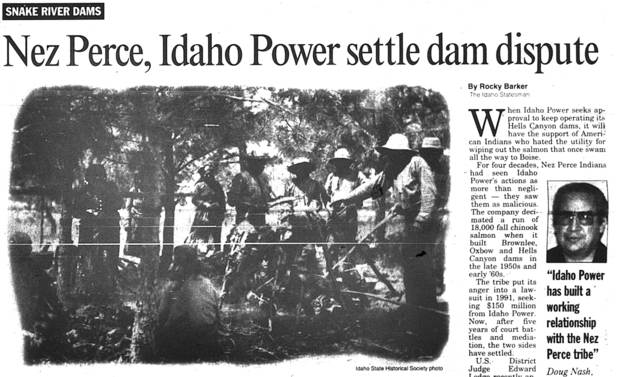forum
library
tutorial
contact

Top 50 Stories: 1956-1967
Hells Canyon Dams Built
by Sven Berg
Idaho Statesman, June 18, 2014
|
the film forum library tutorial contact |

|
Top 50 Stories: 1956-1967
by Sven Berg
|
The Brownlee-Oxbow-Hells Canyon Complex provided cheap power but depressed region's fish populations
 Long before water started gathering behind Idaho Power Co.'s Snake River dams, the "Oxbow Incident" of 1958 cemented fears that the dams would harm fish populations.
Long before water started gathering behind Idaho Power Co.'s Snake River dams, the "Oxbow Incident" of 1958 cemented fears that the dams would harm fish populations.
More than 50 years after that incident, however, energy from the Oxbow, Brownlee and Hells Canyon dams remains a buttress of Idaho's economy.
Officially, more than 4,000 fall chinook and steelhead died in the Oxbow Incident, which occurred when water from the dam diversion tunnel undermined the project's cofferdam, which kept water out of the main construction area.
On Sept. 3, 1958, the cofferdam was breached and water rushed into the construction area.
Fish were migrating upstream at the time, and most couldn't fight their way through the torrent. Many didn't retreat downstream and were trapped in the construction area when the river was once again diverted through the tunnel.
The loss of several thousand fish alone might not have devastated fish populations long-term, but the incident was a public relations disaster.
Since the 1960s, when Idaho Power built the Oxbow, Brownlee and Hells Canyon dams, people have blamed the utility company for declining populations of fish that migrate to and from the ocean and freshwater streams in Idaho.
They've had plenty of ammunition.
The number of salmon returning to the rivers above Hells Canyon fell from historic norms of 1 million to none in the 1970s.
Together, the Hells Canyon Complex has a production capacity of more than 1,000 megawatts, pushing electricity to homes and businesses through much of Idaho at, for a time, the cheapest rates in the country. The Brownlee Dam alone - Idaho Power's most productive - has a capacity of 585 megawatts.
That energy has played a huge role in developing Idaho's economy.
learn more on topics covered in the film
see the video
read the script
learn the songs
discussion forum
